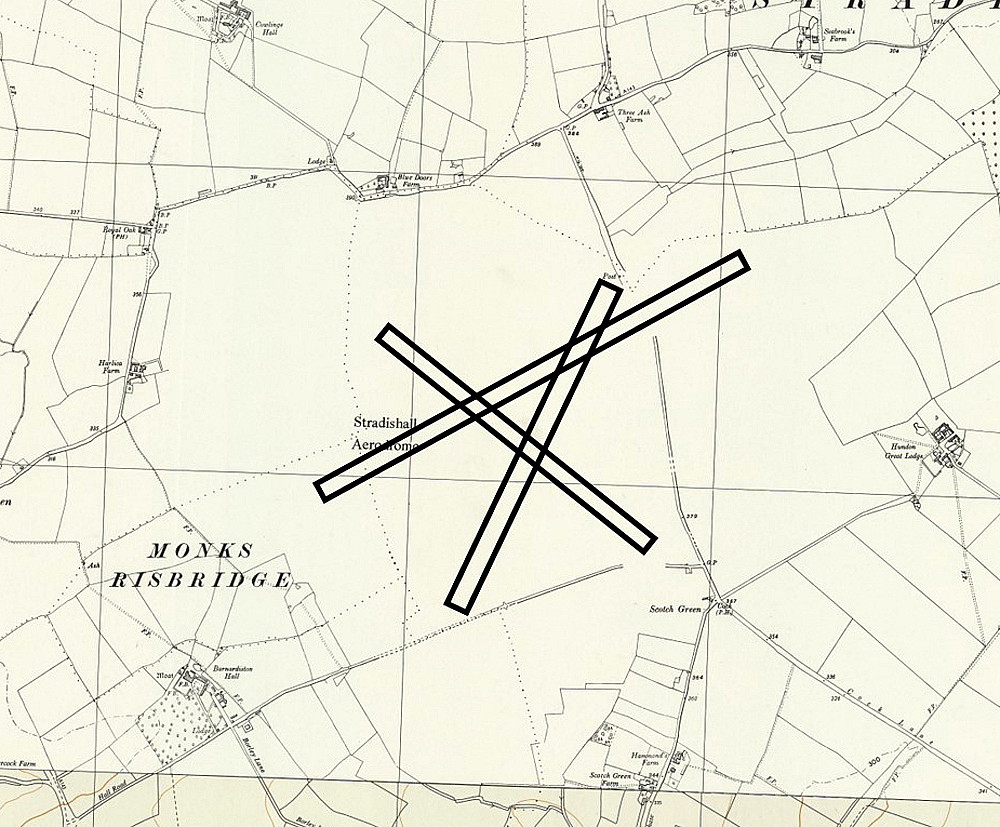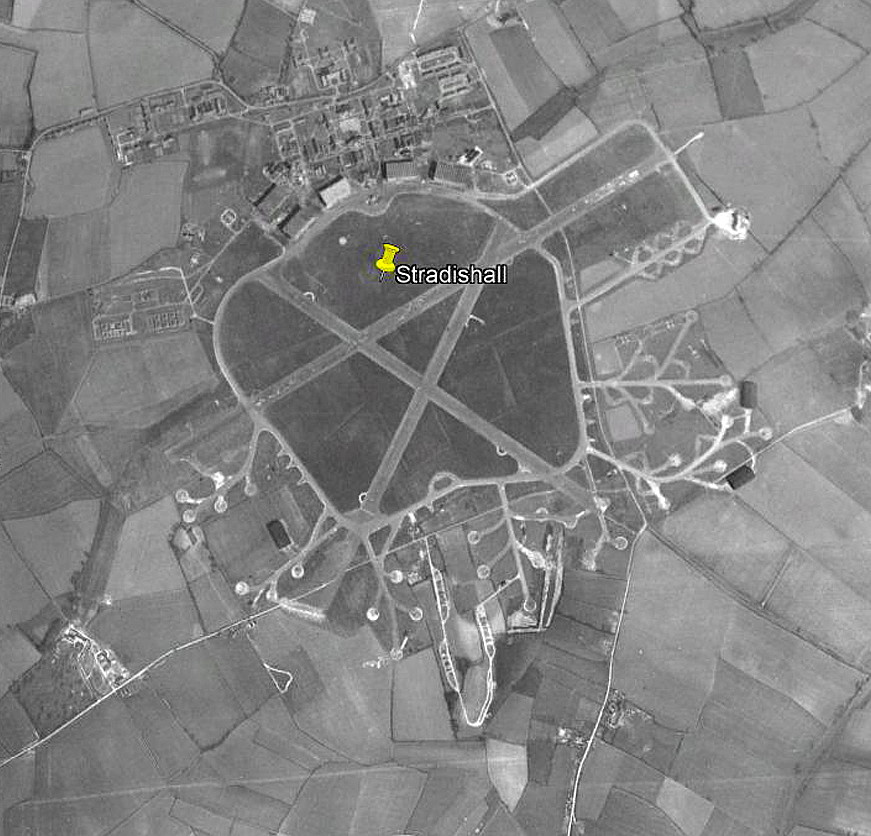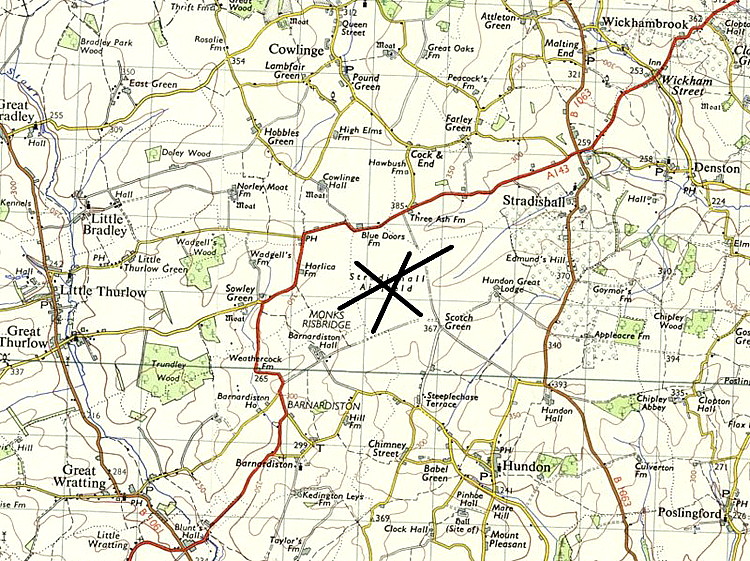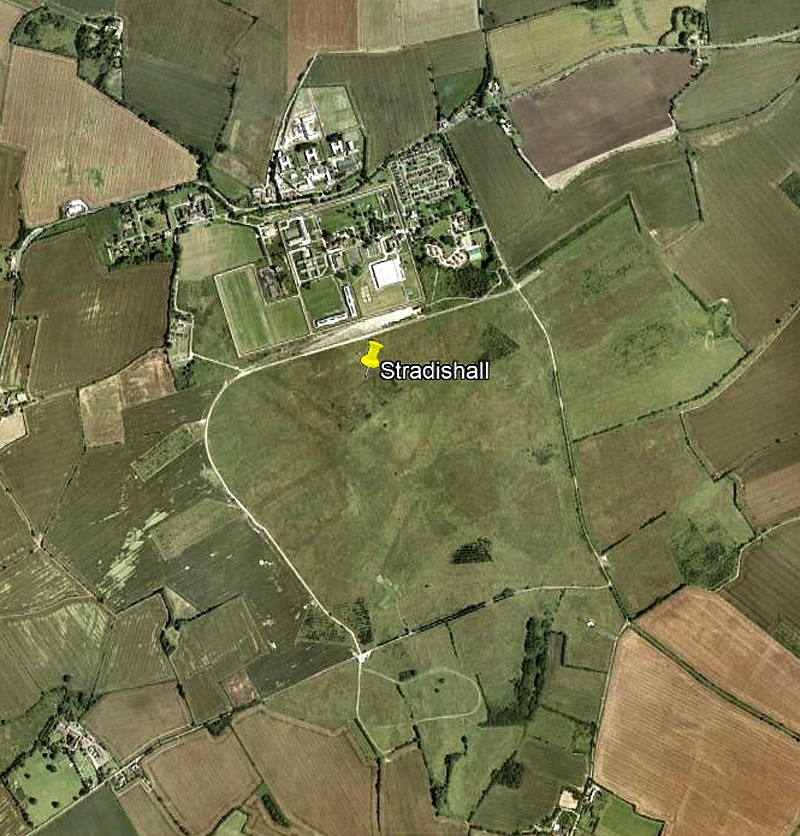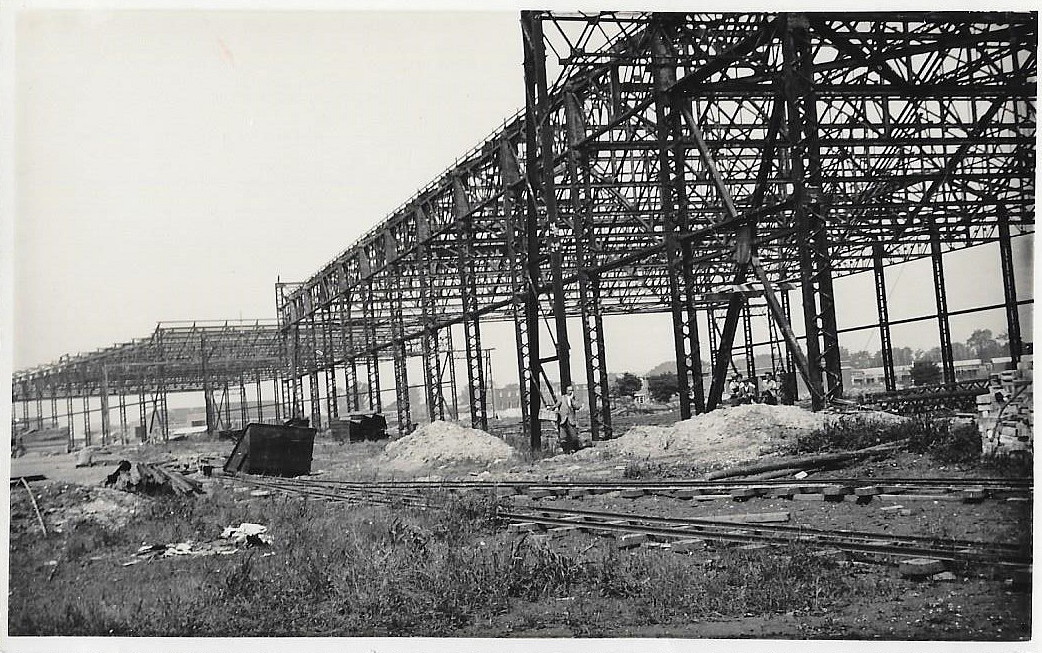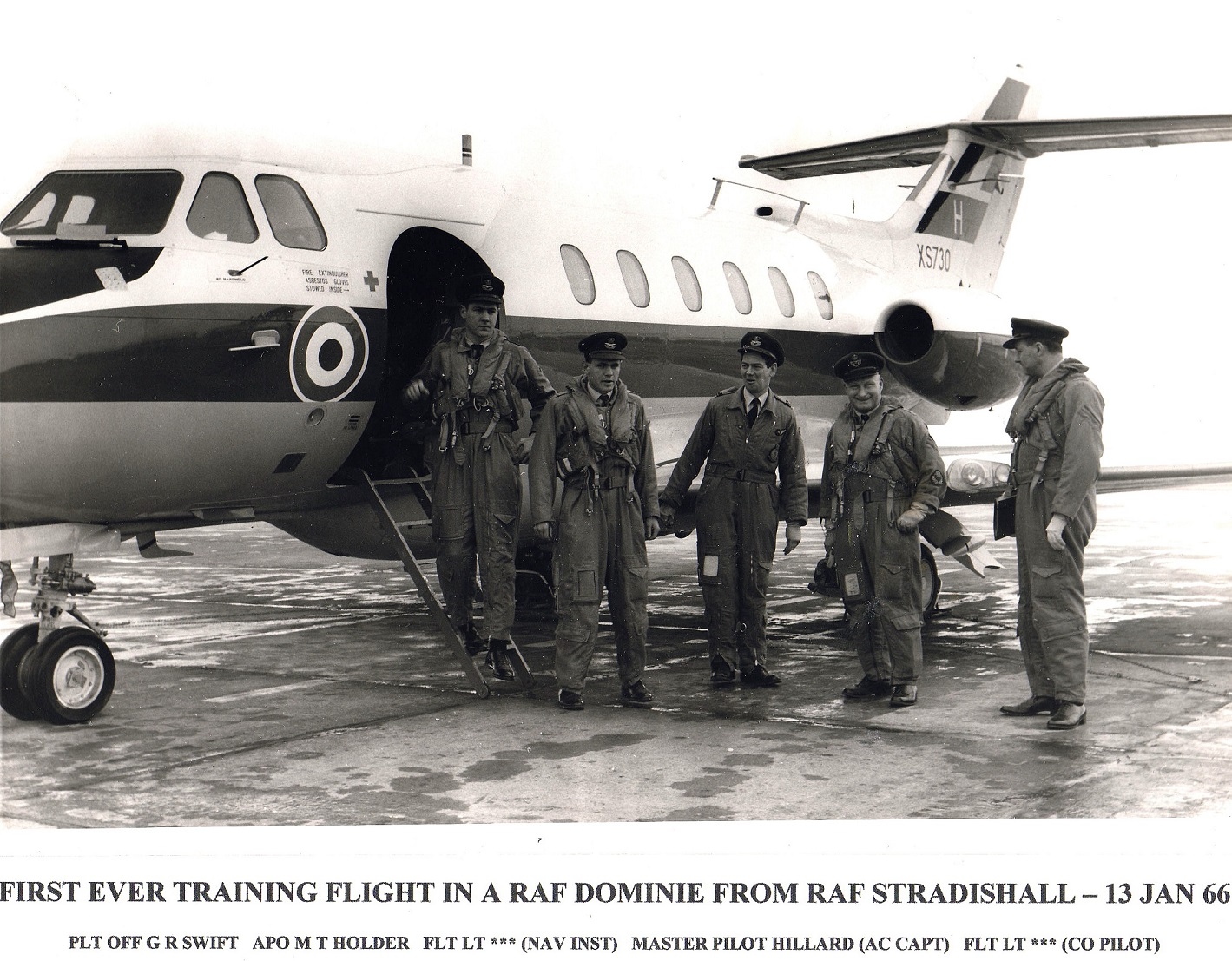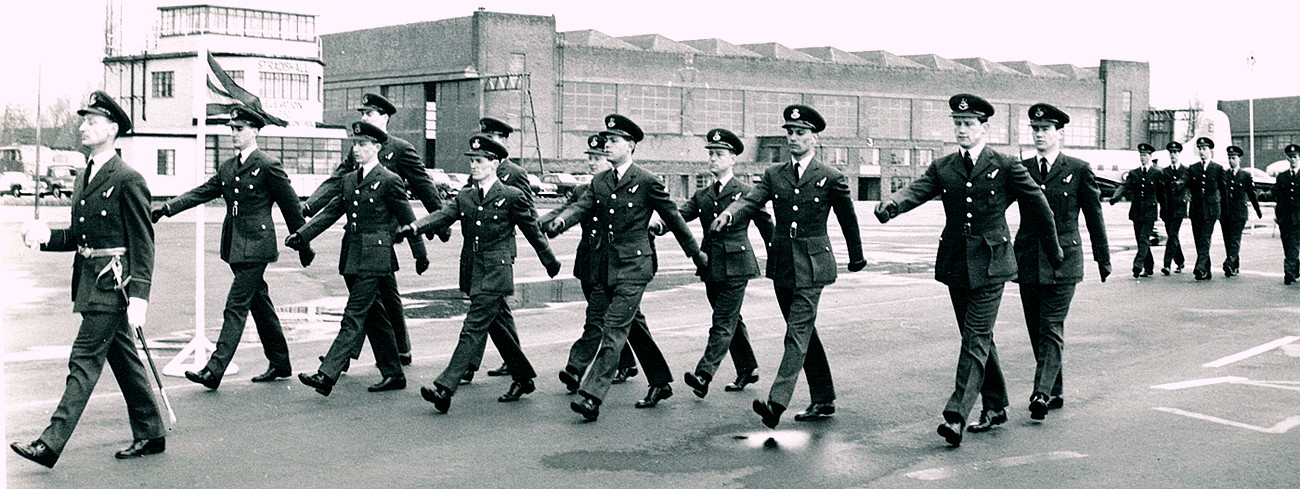Stradishall
STRADISHALL: Military aerodrome
Note: These maps and pictures were kindly provided by Mike Holder
Note: Mike Charlton very kindly sent this, presumably quite rare picture, in March 2020. It shows the hangars being erected in 1937/8.
Military users: WW2: RAF Bomber Command 3 Group
148(B) Sqdn (Vickers Wellingtons)
214 Sqdn (Wellingtons)
1521 BAT Flight (Airspeed Oxfords)
1657 HCU (Short Stirlings, Avro Lancasters & Airspeed Oxfords)
138 SD [Special Duties] Sqdn (Armstrong-Whitworth Whitleys, Westland Lysanders and Short Stirlings)
161 SD Sqdn (Lockheed Hudsons, Westand Lysanders,and Short Stirlings)
186 Sqdn (Avro Lancasters)
218 Sqdn (Short Stirlings)
Post 1945: Bomber Command
149 Sqdn (Avro Lancasters)
RAF Fighter Command 12 Group
203 AFS (became 226 OCU) (Gloster Meteors)
Became a USAF base, at least during the mid 1950s (any info known?)
RAF 1950s: 89 Sqdn (de Havilland DH112 Venoms)
89 Sqdn, (renamed 85 Sqdn in 1956) Gloster Javelins
RAF 1960s: 1 & 54 Sqdns (Hawker Hunters)
No.1 Air Navigation School (Vickers Varsity & BAe 125 Dominie)
Location: S to E of A143, NE of Barnardiston Hall, 5nm NE of Haverhill
Period of operation: 1938 to 1970
Runways: WW2: 07/25 1829x46 hard 14/32 1280x46 hard
04/22 1280x46 hard
NOTES: There was one point I picked up; in late 1944 there were 2210 RAF personnel based here with 534 WAAFs - this is getting close to a 4:1 ratio. I certainly can’t say this is a ‘record’ but it is unusual. Is it any surprise to find this site was yet another HM prison in 1985?
SOMETHING TO CONSIDER
Possibly one aspect of Bomber Command operations is generally forgotten about today? During WW2 many bomber squadrons, both in advanced training and operational duties and flying obsolete aircraft were expected to take part in the overall bombing campaign. Sometimes they took part in the main raids, sometimes on decoy missions. Either way they were ‘sitting ducks’ for enemy retaliation as often as not.
‘Bomber’ Harris and his “mates” at Command Headquarters thought nothing of sacrificing a couple of hundred lives or more for a major raid, knowing full well they had little chance of surviving, or if they did manage to bail out becoming PoWs and therefore making no further contribution. The whole bombing campaign was a very brutal affair on both sides but is was a matter of extreme necessity, especially before the Americans joined in. What seems to be often overlooked today was that bombing was the only method by which the war could be taken to Germany itself.
The subject of area bombing of German towns and cities will I suppose always be a matter of fierce argument. It would appear there are two very good reasons for doing so. The first being that in the early years of WW2 most RAF bomber crews were not able to navigate accurately enough to pin point individual targets in the earlier stages. This was as much a technical problem, (not having the equipment to do so), as lack of expertise by navigators. The second was revenge for the area bombing of British cities the Germans had started. It does appear that most crews were driven by the thought, “You will reap the rewards from what you have sown.” Quite rightly too.
WEATHER ISSUES
I think it is also fair to say that the role weather played in the initial stages of WW2 especially had a huge impact on bomber crews as there was almost nothing the weather might do which favoured them. The same went for the phase the moon was in. For example on a clear night with a full moon they stood a very good chance of bombing the target, but flew silhouetted against the moonlight – ideal for fighters attacking from beneath. Indeed, no RAF bomber was designed and equipped to have adequate defence against a cannon equipped German night fighter, no matter from what quarter it came from.
If the sky was mostly cloudy it might have provided some cover from night fighter attack but the risk of collision was greatly increased, and of course it was highly likely they couldn’t visually acquire the target area. Many thousands of tons of bombs fell outside the towns and cities. Bomber Command chiefs were very aware of this. In the last two years of the bomber offensive success relied increasingly on a war dependent on boffins to invent better means to navigate, attack and providing countermeasures for defence.
But the Germans had boffins too, and bloody good boffins too. On the other hand the simplest technique could be very effective, at least for a while. Like ‘Tinsel’ which involved dropping large amounts of metallic strips to confuse radar. Another was getting German speakers flying in the raid, (or at least nearby), to broadcast conflicting orders and directions on the frequencies used by German night fighters. This technique was not without humour as German ground-controllers became increasingly agitated and frustrated – some becoming furious.
SPECIAL DUTIES
STRADISHALL also had, for a time, in 1940 and 1941, and involvement with the highly secret No. 419 Flight - later renumbered 1419 Flight to avoid confusion with 419 Squadron. In around September 1940 the Flight had two or three Westland Lysanders and two Armstrong-Whitworth Whitleys. The Lysanders were for dropping off and picking up 'agents' plus limited supplies, and the Whitleys for parachuting supplies and 'agents' to help Resistance movements, mainly in France. This later became 138 and 161 Squadrons based at TEMPSFORD (BEDFORDSHIRE).
This said, most 'active' operations departed from TANGMERE in SUSSEX. For more information the book 'WE LANDED BY MOONLIGHT' by Hugh Verity is highly recomended - an excellent read.
On the 18th December 1941 it appears that 138 (Special Duties) Squadron moved from NEWMARKET to STRADISHALL and the fleet strength was doubled to twelve Armstrong-Whitworth Whitleys, three Handley Page Halifaxs and three Westland Lysanders.
THE HAWKER HUNTER
In his excellent book Britain’s Greatest Aircraft Robert Jackson has this to say about the involvement of the Hawker Hunter at STRADISHALL: “In January 1960, No.38 Group, originally formed in 1942 to provide airlift facilities for the British Army, was re-formed at Upavon in Wiltshire and two Hunter squadrons, Nos 1 and 54, based at Stradishall in Suffolk with Hunter F.6s, were designated to provide its offensive element. The planned role of the two squadrons required them to be rearmed with the Hunter FGA.9, but as priority was given to the re-equipment of squadrons in Malaya, Hong Kong and the Middle East with this variant, it was to be early 1961 before the two Stradishall squadrons received their first ground-attack Hunters. The squadrons were formally transferred from RAF Fighter Command to No.38 Group in December 1961 and relocated at RAF Waterbeach, moving to West Raynham in August 1963.”
TWO PICTURES
These two pictures were kindly sent by Mike Holder, a great friend of this 'Guide'. The first shows the crew emerging, (Mike 2nd from left), on the 15th January 1966 after the first ever training flight in a Dominie from STRADISHALL. Passing Out Parade, Mike is third from the right, front row.
COLD WAR MEMORIES
Learning this has caused me to try and reassess what was actually going on at this time. Being a keen spotter and aged fourteen in 1961 my main impression of military priority would have been the all-out nuclear war threat from the Soviet Union – the ‘Cold War’. I cannot recall any of my mates or my or their parents being much concerned about this and indeed, living next to HEATHROW and watching Aeroflot airliners landing every day, it all seemed something that only military people liked to play about with.
This said I suppose that our parents, who had just lived through WW2, had a pretty robust attitude regarding a nuclear war and had probably worked out that converting our semi-detached house into a bunker wasn’t really practical – given the four minute warning!
AN INTERESTING MEMORY
In January 2022 I was kindly contacted by Iain (Jock) Mackinnon, who described himself as being a very happy 84 year old.
"I was posted to Stradishall in 1955 as a trainee engine mechanic and joined 89 Squadron who had just been converted to Venoms. On my first day before joining the squadron to work I explored the airfield and to my delight found in the Station Flight hangar two Mosquitos. I was surprised at their size as I had never seen one before, and had only built models of them when at school."
He then tells us: "I was told that they had been used at Stradishall for target towing. Two days later I went to see them again only to be told they had gone to be museum aircraft." (My note: I wonder where they went to? Can anybody kindly offer advice?)
"89 Squadron lost two Venoms with accidents at that time. One, WX884, crashed into orchards on the outskirts of Stadishall village and burnt out. Both crew were killed. I was on guard duty on the crash site, and eventually was part of the funeral party in Haverhill cemetery for the pilot."
POSTED ABROAD
"89 Squadron were converted to Javelins and renamed 85 Squadron in 1956. I was sent to Nicosia, (My note - in Cyprus), and joined No.1 Squadron for the Suez War but returned to Stradishall and 85 Squadron who then moved to West Malling in Kent. I returned to Stradishall and joined No.1 Squadron there as they had taken over the mantle of the Hunter squadron. 263 Squadron I think?"
A BIT MORE INFO I WANT TO ADD
"I married a girl from Hundon village on the south side of the airfield and lived in that area after leaving the RAF for fourteen years. I now live near Chichester in Sussex where I have been for over fifty years. I have been a volunteer at Tangmere Military Aviation Museum, (home of No.1 Squadron), for eighteen years now and one of 'my' Hunters from No.1 Squadron in the 1956 Suez War is here on display."
One of the joys, and privilege, of compiling this 'Guide' is to be able to record memories such as this. Plus of course, Iain has filled in a couple of gaps left in my notes above, of squadrons operating here.
Terry Clark
This comment was written on: 2018-02-03 00:19:07When I went to ATC camp at Stradishall in 1967, it was the home of No 1 Air Navigation School with Dominies and Varsities. One of the other 'senior' cadets and me 'dodged' sunday church parade and took a walk round the airfield. On the south side were dispersals with with brick built 'blast pens' round them, each having a hut with a garage big enough to house a small truck. They were in surprisingly good condition as if they had only been disused for a few weeks instead of many years.
graham birch
This comment was written on: 2019-09-27 00:02:39Hi my father was in 1657hcu. He was stationed at Stradishall and chedburgh. His name was Alfred Broyden Birch. he was a leading aircraftman. Would you know what job he would be doing at this time please.
Dick Flute
This comment was written on: 2019-09-27 20:42:50Hi Graham, I'm afraid I cannot help but I shall keep this request posted. Hopefully somebody can kindly offer advice. Best regards, Dick
Michael Holder
This comment was written on: 2020-05-17 17:56:37In December 1961 Stradishall became a Training Command with Number 1 Air Navigation School with Varsities and Meteors, then Dominies until August 1970. I had my first training flight on the Dominie on 13 Jan 1966. We - 75 Course - were the first course to use the Dominie. The course ahead of us were the last to use the meteor.
John McClelland
This comment was written on: 2020-11-25 11:28:52I was posted to Stradishall 1954 doing my National Service, I had been training at Yatesbury as a wireless mechanic and was then posted there. At that time it was a training camp for fighter pilots, being trained on Meteors and Vampires the later Venoms and eventually Hunters. It was a brilliant place to do National Service and while I was there Whittles son was there training , I only remember him as he made me salute him once when I was on the other side of a road. Being a farmer, and tractor driver, I used to tow the planes in and out of the hangers. Only had one accident there when during a show put on by the pilots one was doing a loop but was much too low and unfortunately crashed much the same as the fairly recent event with a Hunter. Apart from that a very happy time.
We'd love to hear from you, so please scroll down to leave a comment!
Leave a comment ...
Copyright (c) UK Airfield Guide















